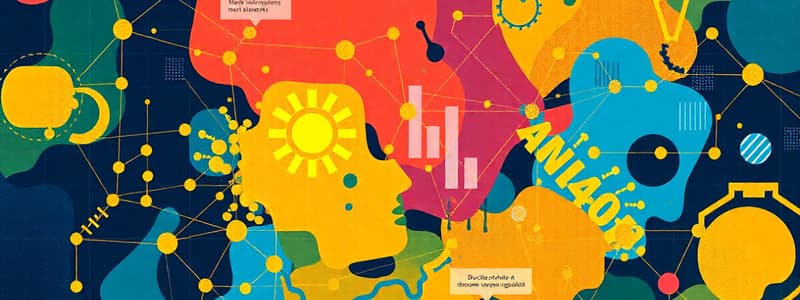Podcast
Questions and Answers
Which of the following best describes the role of analysis in blockchain deployment?
Which of the following best describes the role of analysis in blockchain deployment?
- Identifying network needs, interdependencies, and participant concerns. (correct)
- Evaluating the risks of decentralizing decision-making processes.
- Enforcing rules for decision-making authority within the blockchain network.
- Establishing the specific governance mode to be adopted.
In which scenario is the chief mode most effective as a blockchain governance structure?
In which scenario is the chief mode most effective as a blockchain governance structure?
- Coordinating processes among departments in a large corporation with strict internal requirements. (correct)
- Managing a blockchain that includes competitors and suppliers in a collaborative framework.
- Facilitating decision-making across multiple organizations where control is shared equally.
- Providing hierarchical governance for public and open blockchain networks.
What is the primary risk of transitioning from a custodian governance mode to a consortium governance mode?
What is the primary risk of transitioning from a custodian governance mode to a consortium governance mode?
- Reduced trust between participants due to the absence of shared authority.
- Increased operational inefficiencies due to centralized decision-making.
- Potential inclusion of competitors and reduced individual control. (correct)
- Lack of transparency between participating organizations.
Which governance mechanism primarily addresses the allocation of tasks and responsibilities among blockchain participants?
Which governance mechanism primarily addresses the allocation of tasks and responsibilities among blockchain participants?
How does the augmented governance framework differ from automated governance?
How does the augmented governance framework differ from automated governance?
In the context of digital governance, which of the following exemplifies actorithmic trust?
In the context of digital governance, which of the following exemplifies actorithmic trust?
What is the primary benefit of isolating in blockchain governance strategies?
What is the primary benefit of isolating in blockchain governance strategies?
How do cybernetic incentives differ from bureaucratic incentives in governance mechanisms?
How do cybernetic incentives differ from bureaucratic incentives in governance mechanisms?
Which governance mode is most likely to face bureaucratic challenges in decision-making?
Which governance mode is most likely to face bureaucratic challenges in decision-making?
What is the primary purpose of feedback loops in maintaining long-term alignment in blockchain networks?
What is the primary purpose of feedback loops in maintaining long-term alignment in blockchain networks?
Streamline Co. has implemented a blockchain network for its supply chain, but some suppliers are hesitant to participate. These suppliers are concerned about sharing sensitive data with competitors who are also part of the network.
Which governance mechanism can Streamline Co. use to build trust and address these concerns?
Streamline Co. has implemented a blockchain network for its supply chain, but some suppliers are hesitant to participate. These suppliers are concerned about sharing sensitive data with competitors who are also part of the network. Which governance mechanism can Streamline Co. use to build trust and address these concerns?
A logistics company is considering adding new delivery partners to its blockchain network to improve last-mile delivery efficiency. These new partners have expressed interest but require time to adapt to the system.
Which strategic move would best help the company integrate new partners?
A logistics company is considering adding new delivery partners to its blockchain network to improve last-mile delivery efficiency. These new partners have expressed interest but require time to adapt to the system. Which strategic move would best help the company integrate new partners?
A ride-sharing platform uses an automated system to assign drivers to customers. Recently, the system failed during high-demand hours, leading to customer complaints. Management is considering changes to its governance approach.
Which governance framework would be most effective in balancing automation with human intervention for better decision-making?
A ride-sharing platform uses an automated system to assign drivers to customers. Recently, the system failed during high-demand hours, leading to customer complaints. Management is considering changes to its governance approach. Which governance framework would be most effective in balancing automation with human intervention for better decision-making?
A group of financial institutions is collaborating on a blockchain to streamline cross-border payments. One of the members is concerned that competitors could misuse the shared data for strategic advantage.
What is the primary governance challenge in this scenario?
A group of financial institutions is collaborating on a blockchain to streamline cross-border payments. One of the members is concerned that competitors could misuse the shared data for strategic advantage. What is the primary governance challenge in this scenario?
An e-commerce company has implemented a blockchain to allow customers to track their orders in real-time. However, some customers complain they still don't understand how the system benefits them.
How can the company enhance customer trust and satisfaction using blockchain technology?
An e-commerce company has implemented a blockchain to allow customers to track their orders in real-time. However, some customers complain they still don't understand how the system benefits them. How can the company enhance customer trust and satisfaction using blockchain technology?
Flashcards
Analysis in blockchain deployment
Analysis in blockchain deployment
The process of analyzing a blockchain deployment by understanding the needs, dependencies, and concerns of its participants.
Chief governance mode
Chief governance mode
A centralized governance structure where one entity has control over the blockchain and its decisions.
Consortium governance mode
Consortium governance mode
A governance mode where various organizations collaborate and share control over the blockchain.
Risk of transitioning from custodian to consortium
Risk of transitioning from custodian to consortium
Signup and view all the flashcards
Coordination in blockchain governance
Coordination in blockchain governance
Signup and view all the flashcards
Augmented governance
Augmented governance
Signup and view all the flashcards
Actorithmic trust
Actorithmic trust
Signup and view all the flashcards
Isolating in blockchain governance
Isolating in blockchain governance
Signup and view all the flashcards
Cybernetic incentives
Cybernetic incentives
Signup and view all the flashcards
Bureaucratic challenges in consortium governance
Bureaucratic challenges in consortium governance
Signup and view all the flashcards
Feedback loops in blockchain networks
Feedback loops in blockchain networks
Signup and view all the flashcards
Control in blockchain networks
Control in blockchain networks
Signup and view all the flashcards
Connecting in blockchain governance
Connecting in blockchain governance
Signup and view all the flashcards
Augmented governance
Augmented governance
Signup and view all the flashcards
Control in collaborative blockchain networks
Control in collaborative blockchain networks
Signup and view all the flashcards
Transparency in blockchain for customers
Transparency in blockchain for customers
Signup and view all the flashcards
Risk evaluation in blockchain
Risk evaluation in blockchain
Signup and view all the flashcards
Custodian governance mode
Custodian governance mode
Signup and view all the flashcards
Determining governance mode
Determining governance mode
Signup and view all the flashcards
Incentives in blockchain
Incentives in blockchain
Signup and view all the flashcards
Automated governance
Automated governance
Signup and view all the flashcards
Consortium governance
Consortium governance
Signup and view all the flashcards
Clan governance mode
Clan governance mode
Signup and view all the flashcards
Relationship management in blockchain
Relationship management in blockchain
Signup and view all the flashcards
Balancing automation and human intervention
Balancing automation and human intervention
Signup and view all the flashcards
Collaborative blockchain networks
Collaborative blockchain networks
Signup and view all the flashcards
Transparency in blockchain
Transparency in blockchain
Signup and view all the flashcards
Adaptive governance
Adaptive governance
Signup and view all the flashcards
Transitioning to blockchain governance
Transitioning to blockchain governance
Signup and view all the flashcards
Study Notes
Blockchain Deployment Analysis
- Analysis in blockchain deployment involves identifying network needs, interdependencies, and participant concerns.
Blockchain Governance Structure
- A blockchain governance structure that is most effective in a collaborative framework among competitors and suppliers is a structure that coordinates processes within a large corporation.
Transitioning from Custodian to Consortium Governance
- The primary risk of transitioning from a custodian governance model to a consortium governance model is that participants may lose a sense of shared authority which will reduce trust among participants.
Allocation of Tasks & Responsibilities
- The allocation of tasks and responsibilities among blockchain participants involves coordination.
Augmented vs. Automated Governance
- Augmented governance combines human and algorithmic trust, whereas automated governance relies solely on algorithmic trust.
Digital Governance - Actorithmic Trust
- Customer choosing an Airbnb property based on reviews and platform algorithms exemplifies actorithmic trust.
Blockchain Governance Strategies
- Isolating blockchain governance strategies primarily benefit from reducing internal dependencies to focus on external participants, and maintaining control by establishing proprietary standards.
Cybernetic vs. Bureaucratic Incentives
- Cybernetic incentives dynamically adjust rewards using feedback loops, whereas bureaucratic incentives rely on pre-established contracts.
Bureaucratic Governance Challenges
- Consortium governance is most likely to face bureaucratic challenges in decision-making.
Feedback Loops in Blockchain Networks
- Feedback loops in blockchain networks help participants adapt to changing governance structures and address evolving needs.
Streamline Co. & Trust Building
- Streamline Co. can use control and the establishment of immutable rules for data usage and access to build trust among its suppliers.
Strategic Partnerships in Blockchain Networks
- Connecting a blockchain network to include external organizations (i.e. partners) is a strategic move helpful for integrating new delivery partners.
Governance Framework for Ride-Sharing Platform
- Implementing an augmented governance framework is most effective for balancing automation with human intervention, resolving complaints from increased customer complaints and better decision-making.
Governance Challenge in Cross-Border Payments
- The key governance challenge in cross-border payments is the concern that competitors may misuse shared data for strategic advantage, so maintaining trust and control should be a top priority.
E-Commerce Company & Customer Trust
- In order to enhance customer trust, an e-commerce company should provide clear communication about the benefits of blockchain technology.
Studying That Suits You
Use AI to generate personalized quizzes and flashcards to suit your learning preferences.




